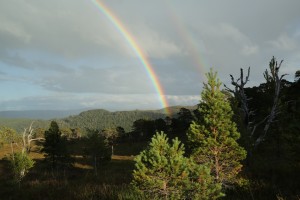
On September 14th this year it was the 25th anniversary of the completion of the first major project for Trees for Life – the protection of the 50 hectare fenced exclosure at Coille Ruigh na Cuileige in Glen Affric. A quarter of a century after the then well-known botanist David Bellamy closed the gate on the exclosure, making it a deer-free zone in an event that gained us considerable media publicity at the time, I went out to the site to see the results that have been achieved since then.
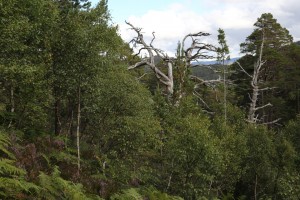
I was accompanied for part of the day by Lynn Cassels, the Site Officer for the Borders Forest Trust (whom I’d met during our study trip to Norway in May this year) and her partner, as they were keen to see some of the work that we’d done to help restore the Caledonian Forest. The Borders Forest Trust is a very similar charity to Trees for Life in many ways, with the aim of restoring native forest in the Borders region of southern Scotland, and they own several sites there, including the Carrifran valley.
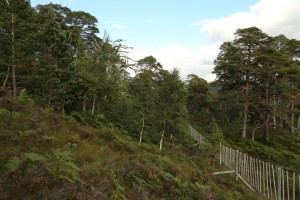
My main purpose for the day was to take a series of photos of the natural regeneration in the Coille Ruigh exclosure, replicating the same viewpoints from images I’d taken in 1990, when the fence was erected, and at various times since then. These would provide a clear visual record of the effects of excluding red deer (Cervus elaphus) from the area. Coille Ruigh is unique amongst the various exclosures in the Glen Affric National Nature Reserve, in that it is the only one in which natural regeneration is the exclusive and only method used to achieve restoration of the Caledonian Forest there – all the others have experienced at least some planting or other conservation management as well.
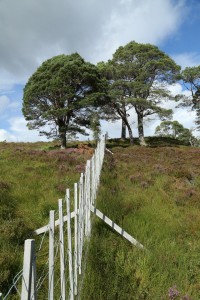
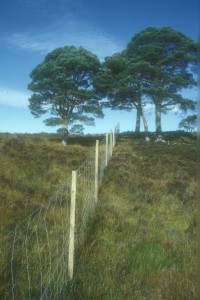
We walked up from the road, and when we reached the exclosure I took the first of the ‘after’ photos, to match the ‘before’ photos from the past – in this case of the fence itself. There was very little change visible here, except for the wooden battens that had been added to the fence to make it more visible to the black grouse (Tetrao tetra) that live in the area.
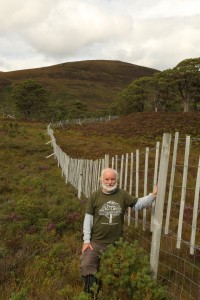
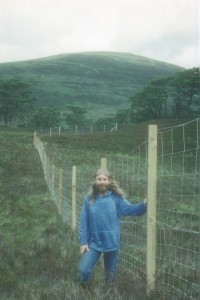
Stepping into the exclosure, we replicated another photo of the fence line, taken at the time of its completion in 1990. It was great having Lynn and her partner Sandra with me, as they were able to take photos like this with me in them, duplicating the same view (and the same posture for me!) as in the earlier photographs – I wouldn’t have been able to do this if I’d been alone.
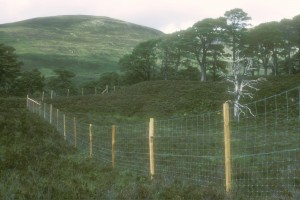
I had brought printed copies of the old photos out with me on the day, so that we could match them precisely, and it took a few minutes at each location to find the same exact spot, select the right lens to give the same angle of view and replicate the image. It was interesting work, and while we did so, it provided an opportunity to observe the changes in each place, and to reflect on what a quarter of a century means in terms of the lives of trees. For Scots pines (Pinus sylvestris) like these, it’s about 10% of their average lifespans, which can range from 250 to over 300 years.
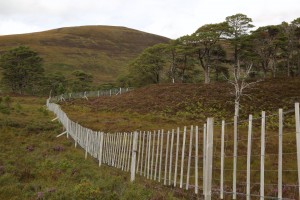
Again, there wasn’t very much change visible near the fence in this part of the exclosure. Most of the ground there is quite wet and boggy, so is not suitable for trees, but a few young pines were growing in one section, where the soil conditions were drier. What was also noticeable for its lack of change was the standing dead pine, or snag, visible in both photos outside the fence. When pines die while they are still standing like that, the wind quickly removes the needles and small branches, and the remaining trunk and larger branches can persist for decades, because of the high resin content in them, which acts as a natural preservative.
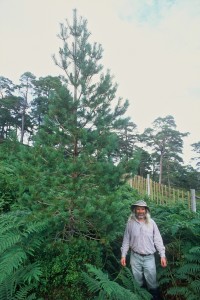

From there, we moved on to the area where the young trees have grown best of all in the exclosure, and to the specific Scots pine that has become known as the ‘Champion pine’. I’ve been photographing this particular tree since 1992, when I chose it to document as it had germinated on a hummock, and so was more visible than the other nearby seedlings.
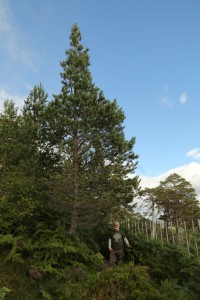
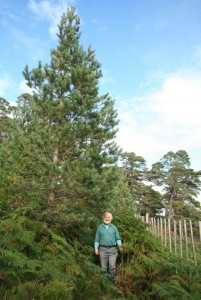
Every two years since 1992 I’ve taken a photo of the tree with me next to it for scale. Those photos have featured on our website, in our magazine and in my slide shows, and the tree has even been on TV clips – it’s had a lot of public exposure. In 2010, for the 20th anniversary of the fence completion, we measured the tree, and we found that it was indeed the tallest one that had regenerated in the exclosure. To me, that was not a coincidence, but rather was a direct result of all the appreciation, care and love that has been directed to the tree, both by me and by all the groups and people that I, and other Trees for Life staff, have taken to it over the years.
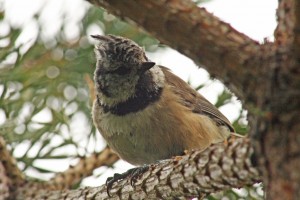
On the day that a colleague and I measured the tree in August 2010, a crested tit (Lophophanus cristatus), landed in it, very close to us. I’ve never seen a crested tit as close as that either before or since then, and it seemed like the bird had come to thank us for giving it a new home to live in. Having had that experience at the time of the 20th anniversary of the fence, I had a half-formed question in my mind if anything similar would occur now, at the 25th anniversary. Well, as Lynn and Sandra took the photo of me beside the champion pine, we were astonished to see a man coming along the outside of the fence towards us! In all the years I’ve been going up to the Coille Ruigh fence, I’ve never seen anyone else there, who’s got there independently of Trees for Life staff and our visits. What was even more remarkable was that as he approached us, he looked at me and said, ‘You must be Alan’! This seemed almost like my personal version of the famous encounter between Henry Stanley and David Livingstone in 1871 in what is now Tanzania, where Stanley found Livingstone after a 700 mile trek, and is reputed to have greeted him with the question, ‘Dr. Livingstone I presume’!
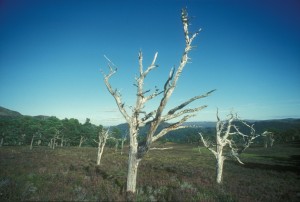
It turned out that he was a student called Tom Langhorne, and he was doing a research project on wood ants (Formica spp.) in conjunction with Trees for Life – he recognised me from photos he’d seen on our website. We talked with him for a few minutes before he left to continue his survey outside the fence for wood ant nests. Shortly afterwards Lynn and Sandra left to head south for their home in Borders, and I went on to the centre of the exclosure, where there are three pine snags I’ve been photographing since 1989.
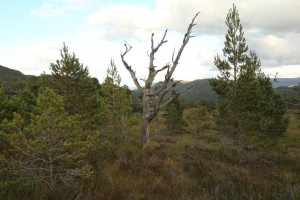
This is the area of the exclosure with the most dramatic changes, as the three pine snags are almost completely unchanged since 1989, when I first photographed them. However, they are now surrounded by healthy young pines that have grown spontaneously since the fence went up, and these now obscure the view of the two more distant pine snags. To me, this area really highlights the rebirth of what was a dying woodland in 1990, when the fence was completed, and this year, for the first time, the new pines have grown taller than the old snags – a potently symbolic result.
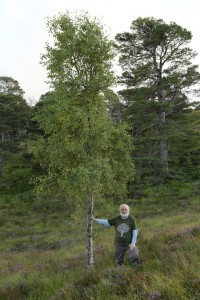
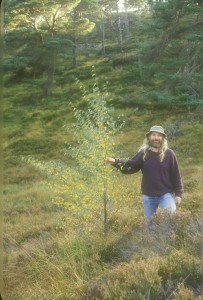
Nearby these three pine snags are several young birches, which are some of the tallest that have grown in the exclosure. I had photographed one of those in 1995, when it was already taller than me, and this was another image that I replicated for this 25th anniversary of the fence. I estimated that the tree is now about 4 times my height.
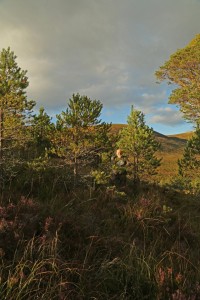
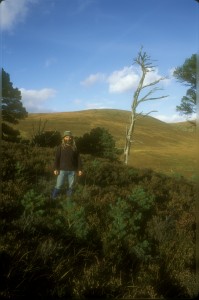
In October 1995, I’d taken a photograph of some then young pines in the same general area in the exclosure, and this was the first time since then that I’d gone back to replicate that image. It wasn’t so easy though, as the dead Scots pine, or snag, that had been prominent in 1995 had fallen over, so it doesn’t feature in the photo from 2015, but otherwise the view is the same as 20 years before.
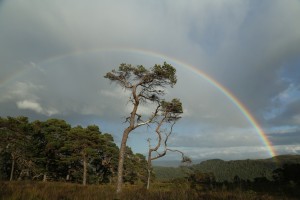
By this time it was getting late in the day and the midges (Culicoides impunctatus), which had been getting progressively worse for the past hour or so, were now almost unbearable, even though I had put insect repellent on all my exposed skin. I decided to call it a day and head back down the hill towards my car, but as I turned around to leave, I was astonished to see a spectacular rainbow in the sky. This was particularly remarkable, as it had been dry all day, and there was no rain now either, but nevertheless there was this stunning arc of prismatic colour in the sky.
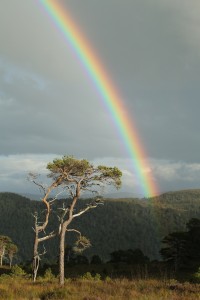
I pulled out my camera again, as this was an exceptional opportunity to document the combination of the pines with the rainbow overhead.
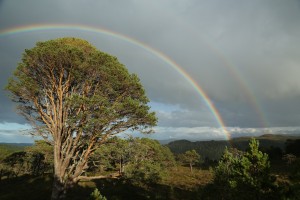
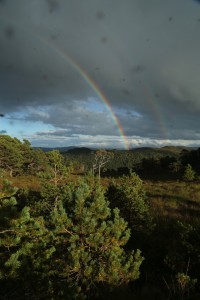
Many of the photographs were affected by the midges though, as literally thousands of them were swarming around me and large numbers were getting on my camera lens.

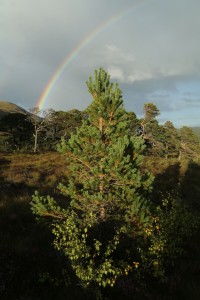
I sometimes think that people have no idea what landscape photographers go through to get some of their images, and that was certainly the case in this instance. It was literally midge hell – one of the worst cases of midges I’ve ever encountered, as they were getting in my eyes, in my ears, and in my mouth if I opened it – the sheer numbers were almost overwhelming. However, I was able to get a few photos without them in the images by waving my hand in front of the camera lens to clear them away just before I took the exposure, but even that was a real challenge! After a few minutes the rainbow faded away, and I made a very quick retreat down the hill to get back to my car, leaving the midges behind.
Coille Ruigh had definitely lived up to its Gaelic name, which translated into English means ‘wooded slope of the midges’! Despite being plagued by them though, I couldn’t help but marvel at the rainbow, which had appeared almost miraculously in the sky. It felt to me very much like the appearance of the crested tit in 2010, when we had been measuring the height of the champion pine for the 20th anniversary of the fence. This time it was the rainbow that seemed to be nature’s feedback about the positive effect that the fence has had on the area. Instead of a pot of gold, there was something of much greater value, importance and beauty at the end of the rainbow – the healthily growing young pines and birches that were returning life to this area, and are the first generation of new trees to have got established here in the past 200 years.
Well done to you and the team at Trees for Life for this life-giving accomplishment. May this example proliferate abundantly all over the world. Thank you for your dedication.
Hi Pupak,
Thanks for the appreciation, and all your support!
With best wishes,
Alan
A wonderful post about a magical thing, Alan! Fixed point photography is such an awesome tool. But the almost-spiritual extra touches, like the rainbow and the Crested Tit, are the icing on the cake. Thanks for the effort – yours and the whole organisation’s. Inspiring stuff; I am so pleased to be a life member.
Hi Martin,
Thanks your appreciation, and also for your support for Trees for Life by being a life member – that’s wonderful.
With best wishes,
Alan
It’s a wonderful story & an example that needs to be spread across the whole of these islands.
Hi Ashley,
Thanks for your comment, and yes it would be great if we could see the recovery of more landscapes like this throughout the UK. The good news is that there are other similar projects underway now – at Carrifran in the Scottish Borders, at Ennerdale in the Lake District and on Dartmoor, to name a few.
With best wishes,
Alan